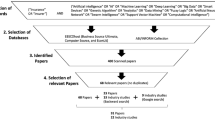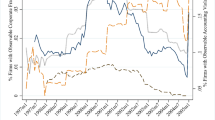Abstract
We discuss the impact of risk sharing and asset–liability management on capital requirements. Our analysis contributes to the evaluation of the merits and deficiencies of different risk measures. In particular, we highlight that the class of V@R-based risk measures allows for a substantial reduction of the total capital requirement in corporate networks that share risks between entities. We provide case studies that complement previous theoretical results and demonstrate their practical relevance. For large networks, optimal asset–liability management is often contrary to those strategies that are desirable from a regulatory point of view.



Similar content being viewed by others
References
Acciaio B (2005) Two Problems Related to Utility Theory Under Unusual Assumptions, PhD thesis, University of Perugia
Acciaio B (2007) Optimal risk sharing with non-monotone monetary functions. Financ Stoch 11(2):267–289
Artzner P, Delbaen F, Eber J-M, Heath D (1999) Coherent measures of risk. Math Financ 9(3):203–228
Asimit AV, Badescu AM, Tsanakas A (2013) Optimal risk transfers in insurance groups. Eur Actuar J 3(1):159–190
Barrieu P, El Karoui N (2005) Inf-convolution of risk measures and optimal risk transfer. Financ Stoch 9:269–298
Barrieu P, El Karoui N (2008) Pricing, hedging and optimally designing derivatives via minimization of risk measures. In: Carmona R (ed) Indifference pricing: theory and applications. Princeton University Press, Princeton
Boonen TJ (2015) Competitive equilibria with distortion risk measures. Astin Bull 45(3):703–728
Borch K (1962) Equilibrium in a reinsurance market. Econometrica 30:424–444
Cont R, Deguest R, Scandolo G (2010) Robustness and sensitivity analysis of risk measurement procedures. Quant Financ 10(6):593–606
Embrechts P, Liu H, Wang R (2018) Quantile-based risk sharing. Oper Res 66(4):936–949
European Commission (2009) Directive 2009/138/EC of the European Parliament and of the Council of 25 November 2009 on the taking-up and pursuit of the business of Insurance and Reinsurance (Solvency II), Directives, Official Journal of the European Commission
Filipovic D, Svindland G (2008) Optimal capital and risk allocations for law- and cash-invariant convex functions. Financ Stoch 12:423–439
Filipovic D, Kupper M (2008) Equilibrium prices for monetary utility functions. Int J Theor Appl Financ 11:325–343
Föllmer H, Schied A (2002) Convex measures of risk and trading constraints. Financ Stoch 6(4):429–447
Föllmer H, Schied A (2016) Stochastic finance—an introduction in discrete time, 4th edn. de Gruyter, Berlin
Föllmer H, Weber S (2015) The axiomatic approach to risk measurement for capital determination. Annu Rev Financ Econ 7:301–337
Galchion A (2010) The V@R at risk. Int J Theor Appl Financ 13(4):503–506
Jouini E, Schachermayer W, Touzi N (2008) Optimal risk sharing for law invariant monetary utility functions. Math Financ 18(2):269–292
Ludkovski M, Young V (2009) Optimal risk sharing under distorted probabilities. Math Financ Econ 2(2):87–105
Raviv A (1979) The design of an optimal insurance policy. Am Econ Rev 69(1):84–96
Weber S (2018) Solvency II, or how to sweep the downside risk under the carpet. Insur Math Econ 82:191–200
Wilson R (1968) The theory of syndicates. Econometrica 36:119–132
Author information
Authors and Affiliations
Corresponding author
Additional information
Publisher's Note
Springer Nature remains neutral with regard to jurisdictional claims in published maps and institutional affiliations.
Disclaimer for Anna-Maria Hamm: The results in this paper are the sole responsibility of the author and do not necessarily represent or reflect the views of HDI Global SE.
Appendices
A Risk measures
We denote by \({\mathcal {X}}\) a vector space of measurable, real-valued functions on a measurable space \((\Omega , {\mathcal {F}})\) that contains the constants. If \({\mathbb {P}}\) is a probability measure on \((\Omega , {\mathcal {F}})\), typical examples of \({\mathcal {X}}\) are \(L^p\)-spaces, \(p\in [1,\infty ]\), where \({\mathbb {P}}\)-almost sure equal functions are identified with each other.
A monetary risk measure\(\rho :{\mathcal {X}}\rightarrow {\mathbb {R}}\) is an inverse monotone and cash-invariant function on \({\mathcal {X}}\):
- 1.
Inverse Monotonicity:\(X,Y\in {\mathcal {X}}, X\le Y\)\(\Rightarrow \)\(\rho (X)\ge \rho (Y)\)
- 2.
Cash-Invariance:\(X\in {\mathcal {X}}, m\in {\mathbb {R}}\)\(\Rightarrow \)\(\rho (X+m)=\rho (X)-m\)
Property 1 states that the risk of a position Y is smaller than the risk of a position X, if the future value of Y is at least X. Property 2 states that risk is measured on a monetary scale: If m Euro are added to X, then the risk of X is exactly reduced by this amount.
In particular, any monetary risk measure corresponds to its acceptance set, \({\mathcal {A}}=\{X\in {\mathcal {X}}:\rho (X)\le 0\}\), from which it can be recovered via
Thus, a monetary risk measure can be viewed as a capital requirement: \(\rho (X)\) is the minimal capital that has to be added to the position X to make it acceptable.
The choice of a meaningful risk measure for capital regulation is subject to an ongoing discussion between academics and practitioners that began in the mid 1990s. Various desirable properties of monetary risk measures have been proposed, and corresponding classes of risk measures have been identified and characterized. A common requirement in the literature is that diversification should not increase risk. In mathematical terms, diversification corresponds to quasi-convexity of \(\rho \), i. e.,
for \(X,Y\in {\mathcal {X}}\) and \(\lambda \in (0,1)\). In that case, \(\rho \) is also a convex functional on \({\mathcal {X}}\). A monetary risk measure is called a convex risk measure if it satisfies condition (11) of quasi-convexity and is hence convex. A convex risk measure is called coherent if it is also positively homogeneous, i. e.,
for \(X\in {\mathcal {X}}\) and \(\lambda \ge 0\). Positive homogeneity is often seen as critical, in particular since the additional concentration risk caused by scaling the financial position is not captured.
A monetary risk measure on a space of random variables \({\mathcal {X}}\) on \((\Omega ,{\mathcal {F}},{\mathbb {P}})\) is distribution-based (sometimes somewhat misleading also called law-invariant), if \(\rho (X)=\rho (Y)\) whenever the distributions of X and Y under \({\mathbb {P}}\) are equal, i. e., \({\mathbb {P}}^X={\mathbb {P}}^Y\) for \(X,Y\in {\mathcal {X}}\).
Distribution-based risk measures include a wide variety of examples, see, e. g., Föllmer and Schied [15] and Föllmer and Weber [16]. Throughout this paper, we focus on three prominent examples with different properties:
- (a)
Value at risk: The most commonly used risk measure in practice—and in particular the prescribed risk measure for Solvency II purposes—is value at risk (\({{\text {V@R}}}\)). For a given level \(\alpha \in (0,1)\), we denote by \({{\text {V@R}}}_\alpha \) the monetary risk measure defined by the acceptance set
$$\begin{aligned} {\mathcal {A}}_{{{\text {V@R}}}_\alpha }=\{X\in {\mathcal {X}}\vert {\mathbb {P}}[X<0]\le \alpha \}. \end{aligned}$$(12)For a financial position X, the value \({{\text {V@R}}}_\alpha (X)\) specifies the smallest monetary amount that needs to be added to X such that the probability of a loss becomes smaller than \(\alpha \):
$$\begin{aligned} {{\text {V@R}}}_\alpha (X)=&\inf \{m\in {\mathbb {R}}\vert {\mathbb {P}}[X+m<0]\le \alpha \}\\ =&-\sup \{c\in {\mathbb {R}}\vert {\mathbb {P}}[X<c]\le \alpha \}=-q_X^+(\alpha ),\nonumber \end{aligned}$$where \(q_X^+(\alpha )\) is the upper \(\alpha \)-quantile of X.
Recall that \({{\text {V@R}}}_\alpha \) has two main deficiencies: Firstly, value at risk is not a convex risk measure and may thus penalize diversification beyond the setting of Gaussian or more generally elliptic financial positions. Secondly, \({{\text {V@R}}}_\alpha \) neglects extreme losses that occur with small probability. These deficiencies of value at risk were a major reason to develop a systematic theory of coherent and convex risk measures, as initiated by Artzner, Delbaen, Eber and Heath [3]; Föllmer and Schied [14].
- (b)
Average value at risk: Another basic example is the average value at risk (\({{\text {AV@R}}}\)), also known as conditional value at risk, tail value at risk, or expected shortfall, which plays a prominent role in the Swiss Solvency Test. The average value at risk at level \(\beta \in (0,1]\) is defined by
$$\begin{aligned} {{\text {AV@R}}}_\beta (X):=\tfrac{1}{\beta }\int _0^\beta {{\text {V@R}}}_\alpha (X)\,d\alpha ,\quad X\in {\mathcal {X}}. \end{aligned}$$In contrast to value at risk, \({{\text {AV@R}}}_\beta \) accounts for extreme losses per definition, and it provides incentives for diversification. More precisely, \({{\text {AV@R}}}_\beta \) is a coherent measure of risk.
- (c)
Range value at risk: Cont, Deguest and Scandolo [9] suggest an alternative to \({{\text {V@R}}}\) and \({{\text {AV@R}}}\), called range value at risk (\({{\text {RV@R}}}\)). Letting \(\alpha , \beta >0\) with \(\alpha + \beta \le 1\), they define
$$\begin{aligned} {{\text {RV@R}}}_{\alpha ,\beta }(X)=\tfrac{1}{\beta }\int _\alpha ^{\alpha +\beta }{{\text {V@R}}}_\gamma (X)\,d\gamma , \quad X\in {\mathcal {X}}. \end{aligned}$$Note that the limiting cases of \({{\text {RV@R}}}_{\alpha , \beta }\) correspond to \({{\text {V@R}}}_{\alpha }\) for \(\beta \rightarrow 0\) and \({{\text {AV@R}}}_\beta \) for \(\alpha \rightarrow 0\). Like \({{\text {V@R}}}\), \({{\text {RV@R}}}\) is a non-convex risk measure, and it may thus penalize diversification.
B Proofs
Proof of Corollary 3.1.
Proof
By Example 2.6, we have \(\Box _{i=1}^{n}{{\text {RV@R}}}_{\alpha _i,\beta _i}(E_1(\delta ))={{\text {RV@R}}}_{\alpha ,\beta }(E_1(\delta ))\) for \(\alpha =\alpha _1+\ldots +\alpha _n\), \(\beta =\max \{\beta _1,\ldots ,\beta _n\}\). It is thus enough to show that
To this end, note first that
since \({{\text {RV@R}}}_{\alpha ,\beta }\) is cash-invariant and positively homogeneous. Hence, it remains to compute
Using the quantile transformation rule for \(S^2_1=f(W_1)\) with the increasing function \(f(x)=S^2_0\exp (\mu -\tfrac{1}{2}\sigma ^2+\sigma x)\) combined with the fact that \(q_X(\gamma )={\mathbb {E}}[X]+\Phi ^{-1}(\gamma )\sigma (X)\) for any normally distributed X, we obtain
Substituting \(y=\Phi ^{-1}(\gamma )\) with \(dy=(1/\varphi (\Phi ^{-1}(\gamma ))d\gamma \) in terms of the density \(\varphi \) of the standard normal distribution leads to
Together with (14) this proves (13). Since
the formulae for \(\Box _{i=1}^{n}{{\text {SCR}}}^{i}_{\mathcal {A}}(E_1(\delta ))\) and \(\Box _{i=1}^{n}{{\text {SCR}}}^{i}_{\mathrm{mean}}(E_1(\delta ))\), respectively, follow from (2) immediately. \(\square \)
Proof of Corollary 3.2.
Proof
Recalling that the limiting cases of \({{\text {RV@R}}}_{\alpha , \beta }\) correspond to \({{\text {V@R}}}_{\alpha }\) for \(\beta \rightarrow 0\) and \({{\text {AV@R}}}_\beta \) for \(\alpha \rightarrow 0\), the claim follows from Example 2.6 and Corollary 3.1. More precisely, we have
In the same manner, we derive
since \(\lim _{\alpha \rightarrow 0}\Phi ^{-1}(\alpha )=-\infty \) and \(\lim _{\alpha \rightarrow 0}\Phi (\Phi ^{-1}(\alpha )-\sigma )=0\). \(\square \)
Rights and permissions
About this article
Cite this article
Hamm, AM., Knispel, T. & Weber, S. Optimal risk sharing in insurance networks. Eur. Actuar. J. 10, 203–234 (2020). https://doi.org/10.1007/s13385-019-00219-9
Received:
Revised:
Accepted:
Published:
Issue Date:
DOI: https://doi.org/10.1007/s13385-019-00219-9




